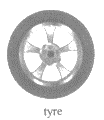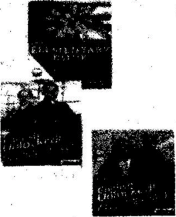Nowadays, people around the world are working to help our earth. Check out how the four young adults made a difference.
| Saving Pandas When Dale was 11, he started a group to teach kids about pandas. He also sold toy pandas to raise money to protect pandas in danger. “I hope to encourage more people to care about pandas,” he says. |
| Creating Energy At the age of 12, Sally invented a machine called Super E. It collects heat from fields to make electricity. Sally says her invention creates electricity in a way that is less harmful to the environment. |
| Cleaning Up Michael, 13, joined the Ocean Heroes Camp last year. He started a project and picked up plastic waste around nearby lakes with his friends. The goal of the project was to fight plastic pollution. |
| Growing Right Helen, 14, set up an organization to educate people about growing right plant in right places. She also wrote a book to help people learn what plants are native (本土的) to their area. |
1. Who started a group to teach kids about pandas?
| A.Michael. | B.Helen. | C.Sally. | D.Dale. |
| A.11. | B.12. | C.13. | D.14. |
| A.To fight plastic pollution. | B.To create electricity. |
| C.To protect pandas in danger. | D.To learn about native plants. |
| A.Dale joined the Ocean Heroes Camp last year. |
| B.Michael hopes more people to care about pandas. |
| C.Sally’s invention is more harmful to the environment. |
| D.Helen set up an organization to educate people about growing right plant in right places. |
| A.In a storybook. | B.In a food magazine. |
| C.In a newspaper. | D.In an advertisement. |
相似题推荐
【推荐1】What do you do with clothes you don’t want to wear anymore? You may donate them or give them to other people. What happens next? Where do these clothes end up?
Sadly, the beaches of Ghana, a country in West Africa, are among these places. Now, the beaches are covered with clothing waste.
People from all over the world donate clothes to charity. However, charity shops only sell up to 20 percent of donated clothes, said The Guardian. The unsold clothes are then put in large bags and travel to other countries to be sold again or for waste disposal (处理).
The Kantamanto market in Accra, the capital of Ghana, is one of the world’s largest secondhand clothing markets. Every week, 20 million pieces of clothes arrive at Kantamanto. But about 40 percent of them leave the market as waste.
Workers either burn the waste or put it underground. However, the city is near the sea, so there’s not enough space for landfills. This is why a lot of clothing waste ends up on the beach.
As it goes into the sea, fish and other sea life are in danger. Sea turtles (海龟) can’t get to the land, and fish can’t grow because they may get caught in the clothes.
The waste is also hurting the economy (经济), Ernest Ijawan, a worker at a landfill in Ghana, told Forbes. Fishers can’t catch as many fish as before since most of the things they catch are clothes.
1. The writer begins the text by ________.| A.giving examples | B.getting readers to think |
| C.telling the results | D.expressing opinions |
| A.They all go to the market to be sold. |
| B.40% of them are used to fill the land. |
| C.Most of them end up at Kantamanto. |
| D.Charity shops only sell a few of them. |
| A.burying waste | B.keeping fish |
| C.trading clothes | D.holding water |
| A.People are easy to get sick. |
| B.Fishing industry is disappearing. |
| C.Sea animals are facing more risks. |
| D.Plants can’t grow well. |
| A.Donation Might Cause Trouble |
| B.Say No to Donated Clothes |
| C.Try to Solve Environmental Problems |
| D.Clothing Waste Is Everywhere |
【推荐2】Upcycling is the process of changing old materials into something useful and often beautiful.

So, is it the same as recycling? No. Recycling takes materials-paper or glass-and breaks them down so their base materials can be remade into a new product. When you upcycle an item(物品), you are not breaking down the material,
you are simply refashioning it. For example, you might make shoes out of old tyres. Also, the upcycled item is typically of the same, or even better, quality(质量) than the original.
Upcycling isn’t a new idea. Some of the best examples of modern-day upcycling come from the 1930s to 1940s when families didn’t have enough materials. In those days, things were repurposed over and over until there were no longer useful. For example, an old door can be made into a new dining table. Economising(节约) is still a trend(趋势) today and a big reason why more and more people upcycle. But an even bigger reason for the rebirth of upcycling is its good influence on the environment.
Upcycling is green. The plain and simple fact of the matter is that upcycling is much better for the planet than throwing things away. When you upcycle, that's one item less that ends upon the waste mountain. Upcycling is also considerably more environmentally friendly than recycling, which needs energy or water to break down materials. Upcycling just needs your own creativity and effort.
Grace Robinson, from the UK, takes used tea bags and turns them into dresses, shoes and even hats. Every day she drinks some tea, and then dries out the tea bags with the tea still in them. When they are dry, she takes the tea out and sews the bags together to make clothes. This can take a long time- maybe months for a single dress -so Grace gets friends to help her by drinking tea too and passing their tea bags on to her.
There are two ways to support the upcycling movement. Sort(分类)through your wardrobe or recycling bin and create items yourself, or buy ready-made items from upcycled materials. Both ways benefit the environment and in return, you get something that’s both attractive and practical.
1. We can learn from the passage that upcycling ___________.| A.can improve the quality of items |
| B.needs more energy than recycling |
| C.needs to break down base materials |
| D.produces more waste than recycling |
| A.giving a new form | B.giving a simple name |
| C.making a perfect copy | D.making a different model |
| A.it is better to make clothes with used tea bags |
| B.upcycling is much greener than recycling |
| C.it is necessary to help others to upcycle |
| D.people need to be more creative |
| A.Get started to recycle today |
| B.A modern trend: upcycling |
| C.Is it the same as recycling? |
| D.To recycle or to upcycle? |
【推荐3】President Xi Jinping says “clear waters and lush mountains are invaluable assets(绿水青山就是金山银山)”. With the efforts of China’s government and its people, the rate of forest coverage(森林覆盖率)in China has increased by 17.91%, compared to 5.05% forty years ago, according to a recent report from the State Forestry and Grassland Administration (SFGA).
Over the past forty years, China planted billions of trees as part of its fight against expanding(延伸的)deserts, mostly in its north. Each year, people sow seedlings(播种)over an area nearly the size of Ireland, according to Nature.
In 1978, China began a nationwide tree-planting programme known as the Three North Shelterbelt Forest Programme, also known as “the Great Green Wall”. It has helped to plant more than 66 billion trees across 13 provinces in the country’s north to act as windbreaks(防风林), according to China Daily.
Since 2018, SFGA has made more efforts to build a greener country. Its purpose is to grow at least 6.7 million hectares(公顷)of forest every year in the next 15 years. Besides planting more trees, China has tried to bring back grasslands. It has also used strict forest protection methods and banned(禁止)all commercial logging(商业伐木)since last August.
The high-speed growth of forests cannot happen without public participation(参与). For example, Ant Forest, an Alipay mobile payment app, plants real trees for users who get “green energy” by taking part in low-carbon(低碳)activities. Since 2016, it has helped to plant about 122 million trees in China’s driest areas.
China was praised as “one of the most successful countries worldwide in greening the desert” by United Nations Environment Programme Executive Director Erik Solheim.
1. What is the rate of forest coverage in China?| A.5.05%. | B.12.86%. | C.17.91%. | D.22.96%. |
| A.People have cut down too many trees. |
| B.People need more trees to build our homes. |
| C.It’s a good way to fight against the expanding deserts. |
| D.President Xi Jinping encourages people to plant trees. |
a. Plan to plant more trees b. Try to bring back grasslands
c. Ban commercial logging d. Encourage to use Ant Forest
| A.bcd | B.abc | C.abd | D.abcd |
| A.Windbreaks have covered across all provinces of China. |
| B.China has grown 6.7 million hectares of forest since 2018. |
| C.In 1978, China succeeded in building “the Great Green Wall”. |
| D.Since 1978, over 66 billion trees have been planted to act as windbreaks. |
| A.To encourage more people to use the app. |
| B.To get people’s attention to China’s driest areas. |
| C.To tell us that Ant Forest can help plant more trees. |
| D.To show that everybody can help build a greener country. |
  Three ways to book tickets for the film. * In person: Box office opens 8:30~16:30 from Monday to Friday. * By telephone: Ring 0534-3685111 to book your tickets and pay by credit card (信用卡). * Online: Complete the online booking form at the website www. xiajintheater. com |  * Please notice: We are unable to change tickets or give money back(退钱) unless the film is cancelled(取消). |
 * Saver: $2 off for children under 12 years old and people over 60 years old * Supersaver: half-price seats for disabled people, only 6 wheelchair(轮椅) spaces * Group bookings:10% discount(折扣) for groups of five or more * School: $6 tickets for school groups of ten or more | |
| A.go to the box office at 14:30 on Tuesday | B.ring and pay by credit card |
| C.book tickets online | D.book tickets by post |
| A.$60 | B.$54 | C.$50 | D.$40 |
| A.Xiaoguang | B.Li Hua | C.Uncle Li | D.Lulu |
| A.Every ticket price is 10 yuan | B.you can change tickets if you want |
| C.you can get your money back at any time | D.there are four kinds of discounts |
| A.In a textbook. | B.In a science report. | C.On the Internet. | D.In a story book. |
A. Amy’s Clothes are only $39 each. Opening time: 10:00 am-10: 00 pm Place: At the corner of Sun Road and Moon Road | B. City Zoo Come and visit the new pandas. Opening time: 9:00 am-6:00 pm Tickets: $40 |
C. Wendy’s One cake and one cup of coffee for only $40. Opening time: 6:00 am-10:00 pm Place: Near Happy Park | D. I&M Music Store Pop and country music. Buy new or used CDs. Listen before you buy. Opening time: 9:00 am-5:00 pm |
E. Tom’s The cheapest fruit store in town, 10% off after 8:00 pm. Opening time: 7:00 am-9:00 pm Place: In front of the Guangming bus stop | F. Roger’s The second-hand store. You can also exchange(交换)things you don’t need with us. Opening time: 12:00 am-9: 00 pm Place: Between Nora’s Bank and Lisa’s Clothes Shop |
【推荐3】

Learn over 500 words and move up a level with the course book English Unlocked. Your complete, self-study English learning pack.
Reading, listening, pronunciation, vocabulary, grammar, progress tests, listen-and-repeat and much, much more.
•Increase your range(范围)of vocabulary!
•Improve your listening skills
•Perfect your pronunciation!
•Develop your reading skills!
English Unlocked will give you the English you need for travel, work, exams and life!
• 6 books to choose from!
•More than 50 hours of learning material!
•Over 100 pages divided into B units!
•3 hours of listening material!
•Videos with exercises!
•Different kinds of English accents(口音)!
Read and listen to this product on an iPad, iPhone, smartphone, tablet computer, PC...
“Best money I ever spent on an English course. My English is so much better now because of this English Unlocked. Thanks Hot English!” Daniel K (Cologne, Germany)
•www.learnhotenglish.com
Tap here to buy!
根据材料内容选择最佳答案。
1. How many words can English Unlocked help us learn?
| A.Less than 500. | B.About 500. | C.More than 500. | D.Over 600. |
| A.An English club. | B.An English dictionary. |
| C.English exercises. | D.Self - study English books. |
| A.Listening and Speaking. | B.Speaking and Writing. |
| C.Listening and Writing. | D.Writing and Reading. |
| A.He thinks it is very expensive. | B.He thinks it is worth(值得)buying. |
| C.He thinks it is proper for kids. | D.He thinks it is a little difficult. |
| A.Culture. | B.News. | C.Advertisements. | D.Pictures. |







